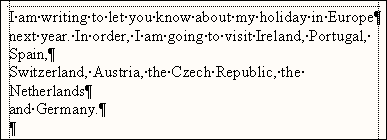2.1 Why you should not press Enter at the end of every line
What this page is about
For those of you who have just joined us, this is a page in the series of Basic Concepts in Word. Use the menu at left to go to the different pages.
Each Basic Concept page has three sections:
- A how-to Tutorial
- Reference section
- Curiosity Shop for the inquisitive.
Tutorial
Within a paragraph, just keep typing
When you use a typewriter, you have to use the carriage return at the end of every line. In a typewriter, the fundamental unit of display, if you like, is a line. You type a line, then use the carriage return.
The fundamental unit in a Word document is a paragraph.
When you use a word processor, such as Word, you don't use the carriage return at the end of every line. You just keep typing. Type type type. Word knows where the margins are. You can see the margins, too: the dotted rectangle on the page shows you where they are. Just keep typing and Word will wrap the text within the margins.
Make sure you can see when you've pressed Enter by clicking the ¶ button on the Standard Toolbar or on the Home tab. The ¶ is the end-of-paragraph marker. It shows you when you've pressed Enter.
Press Enter to indicate the end of a paragraph, not the end of a line.
An explanation: If you press Enter at the end of every line, it is difficult to edit your text
There are about 758 good reasons not to press Enter at the end of every line. But the fundamental reason is this.
The point of using Word is so you can change things. In the old days, when you made a really big mistake, you would rip the page out of the typewriter with a flourish. You'd hear that satisfying whirr of the roller and you would throw the paper in the bin. No longer. In Word, if you make a mistake, or change your mind, you just go back and change the text.
So, imagine you typed the following in a letter. With Word showing you end-of-paragraph marks as a ¶ and spaces with a dot between words, you can see exactly what you've typed.

Even as you finish the paragraph you realize that you left out Portugal. You are visiting Portugal between Ireland and Spain. Now, what do you have to do?
If you had pressed Enter at the end of every line, and you later go back to insert Portugal, this is what you'll see:

So now you have a mess. You have to go and delete the paragraph breaks and clean up every line separately. But if you had pressed Enter only at the end of the paragraph, and you went back to insert Portugal, Word just wraps the text within the margin, like this:

The moral of the tale is simple: don't press Enter at the end of every line. Press Enter at the end of every paragraph.
Reference
- Don't press Enter at the end of every line.
- Press Enter once at the end of every paragraph.
Curiosity Shop: The Any Key
There doesn't seem to be a lot more to say about the Enter key (except, perhaps, that it used to be called the Return key, named after typewriters' carriage returns).
But have you yet found the Any Key?
You would be surprised at the number times that technical support people tell the story about a new computer user, faced with a message saying "Press any key to continue", who searches the keyboard for the Any Key.
- Compaq are very serious (well, they were until Hewlett Packard took them over). They created a whole FAQ (Frequently Asked Question) about the Any Key.
- For a bit of amusement about the Any Key see this newsgroup report from 1992.
- For the ultimate Any Key user, you can buy an Any Key or even get the T-Shirt [Lene Fredborg, 28-Nov-2019: Removed outdated link]


